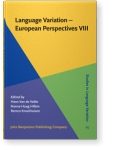References
Aurrekoetxea, Gotzon, Ariane Ensunza Aldamizetxebarria, Hans Van de Velde & Jožica Škofic (eds.). 2020. DIACLEU: Dialect classification of languages in Europe [Website]. [URL] (7 January 2021).
Boer, Meike M. de & Willemijn F. L. Heeren. 2020. Cross-linguistic filled pause realization: The acoustics of uh and um in native Dutch and non-native English. Journal of the Acoustical Society of America 148(6). 3612–3622. 

Brand, Sophie & Mirjam Ernestus. 2019. Understanding reduced words: The relevance of reduction degree and frequency of occurrence. In Sasha Calhoun, Paola Escudero, Marija Tabain & Paul Warren (eds.), Proceedings of the 19th International Congress of Phonetic Sciences, Melbourne, Australia 2019, 91–101. Canberra: Australasian Speech Science and Technology Association Inc.
Coler, Matt & Andrew Nevins. forthcoming. Minoritized and diaspora languages of Europe and linguistic contact. Berlin: Language Science Press.
De Smet, Isabeau & Freek Van de Velde. 2020. A corpus-based quantitative analysis of twelve centuries of preterite and past participle morphology in Dutch. Language Variation and Change 32(2). 241–265. 

Doreleijers, Kristel, Marjo van Koppen & Jos Swanenberg. 2020. De dynamiek van geslachtsmarkering in de Noord-Brabantse dialecten. Taal en Tongval 72(1). 

Franco, Karlien, Dirk Geeraerts, Dirk Speelman & Roeland van Hout. 2019. Concept characteristics and variation in lexical diversity in two Dutch dialect areas. Cognitive Linguistics 30(1). 205–242. 

Goldshtein, Yonatan & Rasmus Puggaard. 2019. Overblik over danske dialektoptagelser. Ord & Sag 39. 18–28.
Grondelaers, Stefan, Dirk Speelman, Chloé Lybaert & Paul van Gent. 2020. Getting a (big) data-based grip on ideological change: Evidence from Belgian Dutch. Journal of Linguistic Geography 8(1). 49–65. 

Halteren, Hans van, Roeland van Hout & Romy Roumans. 2018. Tweet geography: Tweet based mapping of dialect features in Limburg. Computational Linguistics in the Netherlands Journal 8. 138–162. [URL]
Hilte, Lisa, Reinhild Vandekerckhove & Walter Daelemans. 2020. Modeling adolescents’ online writing practices: The sociolectometry of non-standard writing on social media. Zeitschrift für Dialektologie und Linguistik 87(2). 173–201. 

Hout, Roeland van & Pieter C. Muysken. 2016. Taming chaos: Chance and variability in the language sciences. In Klaas Landsman & Ellen van Wolde (eds.), The challenge of chance: A multidisciplinary approach from science and the humanities, 249–266. Dordrecht: Springer Verlag. 

Jansen, Sandra & Natalie Braber. 2020.
foot-fronting and foot-strut splitting: Vowel variation in the East Midlands. English Language & Linguistics [Online First]. 

Kopf, Kristin. 2021a. Genitiv- und von-Attribute. In Marek Konopka, Angelika Wöllstein & Ekkehard Felder (eds.), Bausteine einer Korpusgrammatik des Deutschen, vol. 2(1). Heidelberg: Heidelberg University Publishing.
Kopf, Kristin. 2021b. Stellung des adnominalen Genitivs. In Marek Konopka, Angelika Wöllstein & Ekkehard Felder (eds.), Bausteine einer Korpusgrammatik des Deutschen, vol. 2(1). Heidelberg: Heidelberg University Publishing.
Lundquist, Björn, Ida Larsson, Maud Westendorp, Eirik Tengesdal & Anders Nøklestad. 2019. Nordic word order database: Motivations, methods, material and infrastructure. Nordic Atlas of Language Structures (NALS) Journal 4(1). 1–33. 

Nodari, Rosalba & Chiara Meluzzi. 2020a. Rhotic degemination in Rome Italian. Studi e Saggi Linguistici 58(2).
Nodari, Rosalba & Chiara Meluzzi. 2020b. Spie sociolinguistiche e percezione della provenienza geografica nell’italiano di Roma. Studi Italiani di Linguistica Teorica e Applicata 49.
Orozco, Rafael & Luz Marcela Hurtado. 2021. A variationist study of subject pronoun expression in Medellín, Colombia. Languages 6(1). 5. 

Pischlöger, Christian. forthcoming.
Jangyš! Uspeh udmurtskogo jazyka v internete s ‘ošibkami’. In Eva Toulouze, Elena Popova & Nikolaj Anisimov (eds.), Sovremennaja udmurtskaja kultura. Tallinn: Tallinn University Press.
Ruutma, Mirjam. 2019. Do contact languages influence the distribution of prepositions in Estonian dialects? Nordic Journal of Linguistics 42(3). 365–384. 

Schweden, Theresa. 2019. Möllers Karl, Schulten Mama und Schmidtenbuur: Soziopragmatik der Personenreferenz im Niederdeutschen synchron und diachron. Zeitschrift für Dialektologie und Linguistik 86(2). 134–154. 

Schweden, Theresa. 2020. s Kaufmanns Ingrid und de Fischer Kurt. Struktur und Soziopragmatik onymischer Genitivphrasen und Komposita im Pfälzischen. In Luise Kempf, Damaris Nübling & Mirjam Schmuck (eds.), Linguistik der Eigennamen (Linguistik – Impulse & Tendenzen 8), 397–424. Berlin: De Gruyter. 

Strelluf, Christopher. 2020.
needs+past participle in regional Englishes on Twitter. World Englishes 39(1). 119–134. 

Sundgren, Eva. 2019. Individuell språklig variation och förändring: Sex informanter inspelade 1967, 1996 och 2018. Svenska landsmål och svenskt folkliv 142. 141–169.
Szmrecsanyi, Benedikt, Jason Grafmiller & Laura Rosseel. 2019. Variation-based distance and similarity modelling: A case study in World Englishes. Frontiers in Artificial Intelligence 2. 23. 

Van de Velde, Hans, Evie Tops & Roeland van Hout. 2013. The spreading of uvular [R] in Flanders. In L. Spreafico & A. Vietti (eds.), Rhotics: New data and perspectives, 225–248. Bolzano: Bolzano University Press.
Voeten, Cesko C. 2020. Individual differences in the adoption of sound change. Language and Speech [Online First]. 

von Essen, María Clara. 2020. On the different ways of being a bidialectal immigrant: The case of Argentineans in Spain. Lengua y Migración/Language and Migration 12(2). 7–43.
Wittenberg, Eva & Andreas Trotzke. forthcoming. A psycholinguistic investigation into diminutive strategies in the East Franconian Noun Phrase: Little schnitzels stay big, but little crooks become nicer. Journal of Germanic Linguistics.
Young, Nathan J. forthcoming. The sociolectal and stylistic variability of rhythm in Stockholm. Language and Speech.
Zenner, Eline, Laura Rosseel & Dirk Speelman. 2020. Starman or Sterrenman: An acquisitional perspective on the social meaning of English in Flanders. International Journal of Bilingualism [Online First]. 

